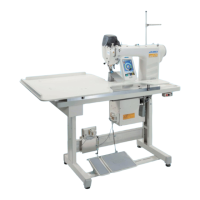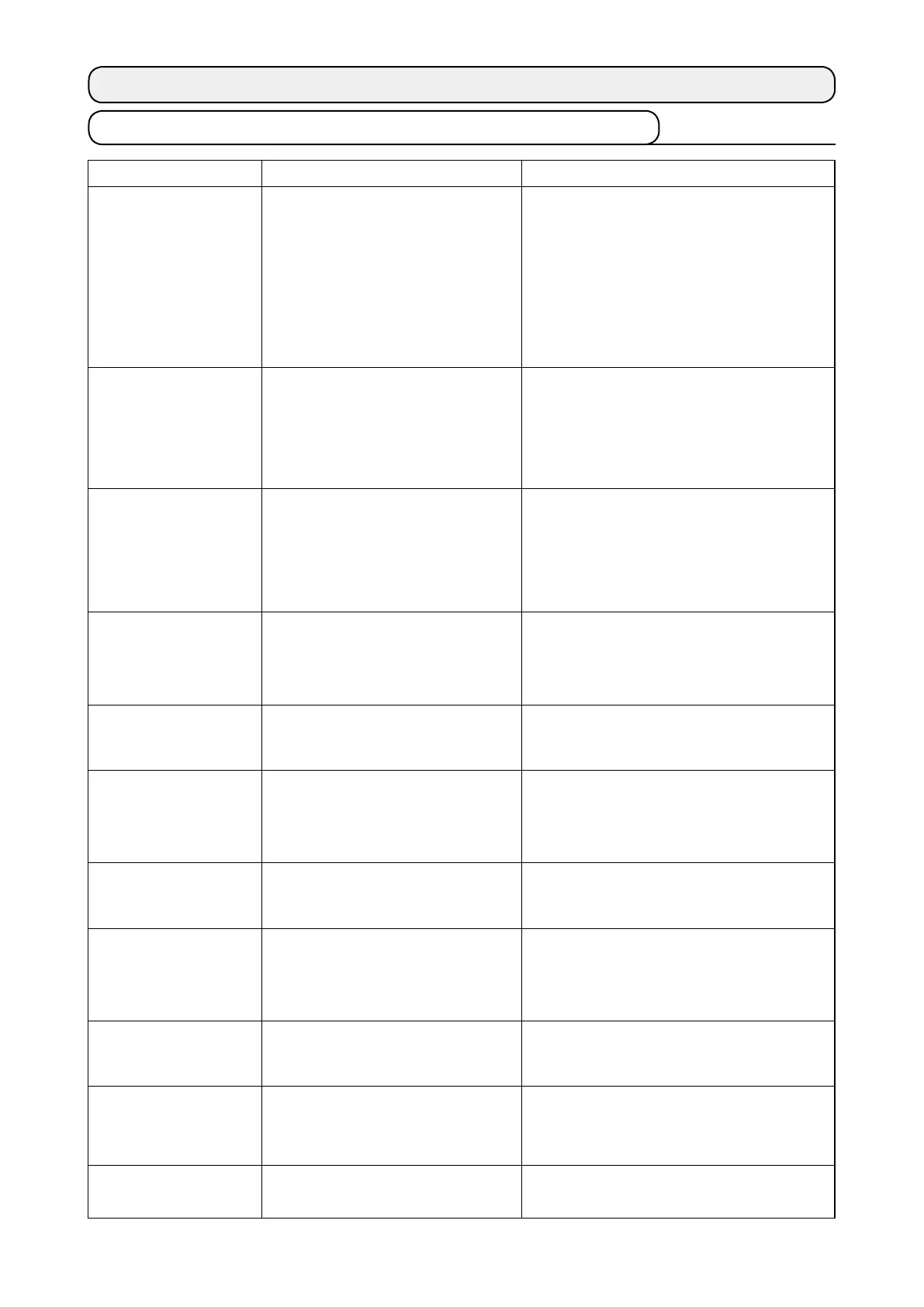–
179
–
25-1 Troubles in sewing and the corrective measures
25. OTHERS
Troubles
Causes Corrective measures
1.
Thread breakage
1
Thread path, needle point, hook blade point
or bobbin case resting on the throat plate
has sharp edges or burrs.
2
Needle thread tension is too high or too low.
3
Needle comes in contact with the blade point
of hook.
4
Thread take-up spring works excessively or
the stroke of the spring is too small.
5
Timing between the needle and the hook is
excessively advanced.
6
Bobbin idling amount is too large.
™
Remove the sharp edges or burrs on the blade point of
hook using a ne emery paper. Buff up the bobbin case
resting groove on the throat plate.
™
Adjust the needle thread tension.
™
Refer to "Adjusting the needle and the hook".
™
Decrease the tension of the thread take-up spring and
increase the stroke of the spring.
™
Refer to "Adjusting the needle and the hook".
™
Increase the spring pressure.
2. Stitch skipping
1
The clearance provide between the needle
and the blade point of hook is too large.
2
Timing between the needle and the hook is
excessively advanced or retarded.
3
Pressure of the presser foot is too low.
4
Height of the walking foot or presser foot is
too high.
™
Refer to "Adjusting the needle and the hook".
™
Refer to "Adjusting the needle and the hook".
™
Tighten the presser spring regulator.
™
Refer to "Adjusting the height of the walking foot and
the presser foot".
3. Loose stitches
1
Bobbin thread is not put in the fork end of the
thread tension spring of the bobbin case.
2
Thread path has been poorly nished.
3
Bobbin fails to move smoothly.
4
Bobbin thread tension is too low.
5
Bobbin has been improperly wound.
™
Thread the bobbin case properly.
™
Grind the thread path using a ne emery paper. Buff up
the thread path.
™
Replace the bobbin.
™
Adjust the bobbin thread tension.
™
Refer to "Winding a bobbin".
4. Thread slips off the
needle
eyelet
simultaneously
with
thread trimming.
1
Returning force of the thread take-up spring
is too strong.
2
Thread tension given by the thread tension
controller No. 1 is too high.
3
Position of the counter knife is improper.
™
Refer to "Threading the machine head".
™
Refer to "Threading the machine head".
™
Refer to "Adjusting the thread trimmer".
5. Needle thread is not
rimmed. Bobbin thread is
trimmed.
1
Stitch skipping at the last stitch (Clearance
provided between the needle and the hook is
excessive.)
™
Refer to "Adjusting the needle and the hook".
6. Both needle thread and
bobbin thread are not
trimmed.
1
Thread trimming timing is improper.
2
Breakage of the knife
3
Pressure of the knife is insufcient.
4
Moving amount of the moving knife is
insufcient.
™
Adjust the thread trimming timing.
™
Replace the knife.
™
Adjust the pressure of the knife.
™
Adjust the initial position of the moving knife.
7. Thread is not cut sharply.
1
Thread trimming timing is improper.
2
Pressure of the knife is insufcient.
3
The knife has a blunt blade.
™
Adjust the thread trimming timing.
™
Adjust the pressure of the knife.
™
Replace the knife.
8. Material bends.
1
Top feed belt is bent.
2
Height of the main walking foot and the
auxiliary walking foot is improper.
3
Auxiliary feed shirring amount set value is
improper.
™
Adjust the walking foot.
™
Make the height of the main walking foot and the
auxiliary walking foot same.
™
Adjust the set value.
9. Feed pitch is not obtained.
1
Feed belt has been worn out.
2
Walking foot is excessively raised.
3
Belt tension is too low.
™
Replace the belt.
™
Refer to "Adjusting the height of the walking foot".
™
Adjust to the proper tension value.
10. Shirring is not performed.
1
Feed belt has been worn out.
2
Walking foot is excessively raised.
3
Belt tension is too low.
4
Set value is too small.
™
Replace the belt.
™
Refer to "Adjusting the height of the walking foot".
™
Adjust to the proper tension value.
™
Adjust to the optimum set value.
11.Shirring is excessively
performed.
1
Set value is too large.
™
Adjust to the optimum set value.

